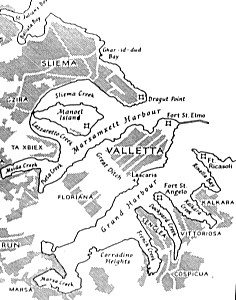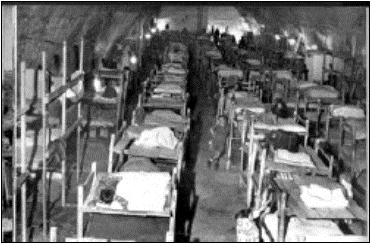
The war in the Maltese airspace had begun just few hours after Italy declared war on Britain and France on 10th June 1940. In this initial attack ten Italian bombers of Regia Aeronautica from a Sicilian airbase dropped their loads onto Malta at 06:50 AM of 11 June 1941 before beating a hasty retreat and for more than three years no month would pass without an air raid over the island.

Regia Aeronautica planes in a Sicilian airbase
preparing to leave for Malta
The only British aircraft present at that time were three elderly Swordfish aircraft - later immortalised as Faith, Hope, and Charity (a nick given by the Maltese) which where left by HMS Eagle to be sent to Egypt. These planes where fond in boxes and after being mounted where used for the first days of war. On 28th November these humble air defences had been bolstered by four Hurricanes and a further 12 Swordfish. Though the latter were largely obsolete they did have a torpedo carrying capacity, and were involved in several of the war's most successful aerial attacks against shipping. Malta enabled British aircraft to fly essential reconnaissance missions over Italian territory, one of which resulted in the devastating air raid on Taranto Harbour where a great number of ships where destroyed or damaged, launched by aircraft from HMS Illustrious on 11th November 1940.
German Ju 87 Stuka aircraft of St.G 2 made their first raid on 10th January 1941 when they attacked and damaged
HMS Illustrious, which limped into Valetta's Grand Harbour after six hits from well-aimed 500 kg bombs. (The carrier's aircraft had been lured away by Italian SM 79 aircraft of 32nd Stormo, allowing the 26 Stukas attacking flight access to the aircraft carrier). Than attacked the Illustrious with many near misses again in the Grand Harbour but with great destruction to the buildings in the nearby villages.

Marsamxett Harbour and Grand Harbour the two main
harbours in Malta

The year 1942 saw an increase in the pounding received by the island fortress. On 1st April the Royal Navy were forced to withdraw their surface ships from the island because of the intense air bombardment. Submarines of 10th Submarine Flotilla stationed in Valetta (Marsamxett Harbour) were forced to submerge at their berths during the day, finally leaving their untenable position in April. That month 7 000-tons of bombs fell on Malta, the most heavily bombarded region of World War Two (followed closely by the German-held city of Brest).
Shelters where dug out by hand in the Maltese rock and in the bastions, which served as shelter from Turks long time ago now served as a shelter from the Axis bombs.

A railway tunnel was turned into a mass shelter on the first day of war.
At the height of the siege, on 15th April 1942 King George VI bestowed the award of the George cross on the island and its people. His message to the inhabitants was:
To honour her brave people I award the George Cross to the island fortress of Malta,
To bear witness to a heroism and devotion that will long be famous in history.

The George Cross awarded to the Maltese island by King George VI

Now see something about the convoys and the brave people who helped to supply Malta with every day needs during the worst days of war in the links below:
The Aircraft Carrier Illustrious
Operation Harpoon: 11-16 June
Operation Pedestal: 11-15 August